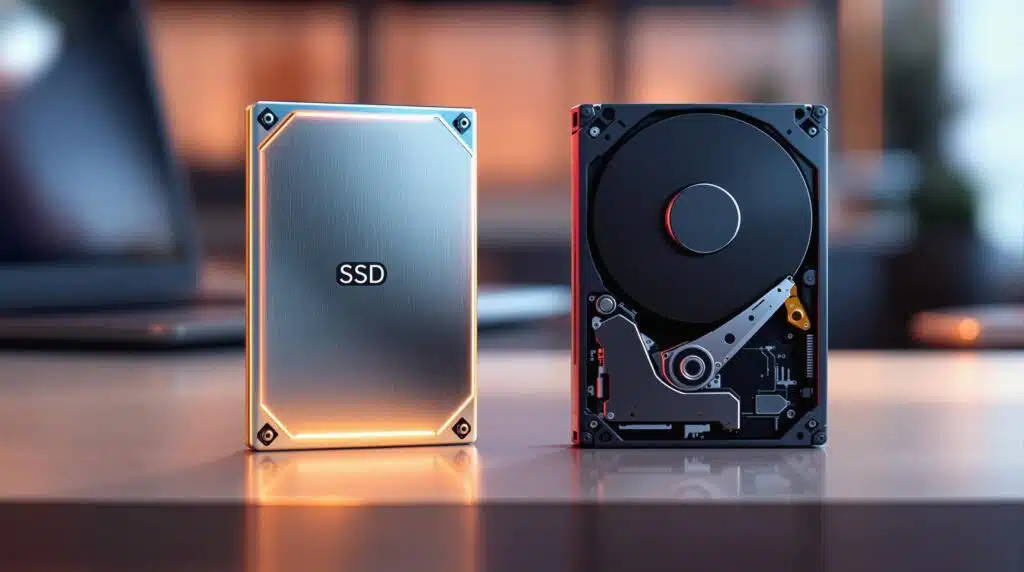Choosing between an SSD and an HDD depends on your needs for speed, storage, and cost. Here’s a quick breakdown to help you decide:
- SSDs: Faster, more reliable, and better for performance-intensive tasks like gaming, professional applications, and quick boot times. Prices start around $0.08–$0.10 per GB.
- HDDs: Cheaper, offering more storage per dollar (around $0.03–$0.06 per GB). Ideal for bulk storage, backups, and media libraries, but much slower.
Quick Comparison
| Feature | SSD | HDD |
|---|---|---|
| Speed | 500–7,300 MB/s | 30–160 MB/s |
| Boot Time | 10–15 seconds | 30–40 seconds |
| Durability | No moving parts, shock-resistant | Moving parts, prone to damage |
| Lifespan | 5–10 years | 4–7 years |
| Cost per GB | $0.08–$0.10 | $0.03–$0.06 |
| Capacity Range | 120GB–30TB | 500GB–36TB |
If you need speed and reliability for daily use or professional tasks, go for an SSD. For large, affordable storage, HDDs are the way to go. A dual-drive setup (SSD for system files and HDD for storage) can offer the best of both worlds.
SSD vs HDD – Which is Best for You?
Speed and Performance Tests
SSDs consistently outperform HDDs in both benchmarks and everyday use, making them the preferred choice for faster and more efficient computing.
Speed Test Results
Modern NVMe SSDs deliver exceptional speed compared to traditional storage options. For example, the Samsung 990 PRO NVMe SSD reaches read speeds of up to 7,300 MB/s, while a standard 7,200 RPM HDD tops out at just 160 MB/s [3]. These speed differences translate into real-world advantages:
| Task Type | HDD | SATA | NVMe |
|---|---|---|---|
| Sequential Read | 80 MB/s | 550 MB/s | 7,300 MB/s |
| Sequential Write | 160 MB/s | 520 MB/s | 6,350 MB/s |
| Boot Time | 4 minutes | 15 seconds | 10 seconds |
| File Copy (50GB) | 25 minutes | 5 minutes | 2 minutes |
Daily Task Performance
The difference in speed is noticeable in everyday tasks. For instance, tests comparing an HDD-equipped HP desktop to an SSD-based Mac revealed:
- Web browsers load almost instantly on SSD systems but take around 15 seconds on HDD systems [4].
- HDD systems require 4 minutes to boot, while SSD systems manage it in just 10 seconds [4].
- File transfers and other operations are far quicker with SSDs.
For professionals, the benefits are even more pronounced, especially in tasks requiring frequent large file access or application switching.
Speed Comparison Data
| Operation Type | HDD | SSD | Performance Gain |
|---|---|---|---|
| Read/Write Process | 0.1–1.7 MB/s | 50–250 MB/s | Up to 147x faster |
| Application Launch | 30–40 seconds | 10–15 seconds | 3x faster |
| Large File Access | 150 MB/s max | 3,500 MB/s max | 23x faster |
| Random Access Time | 5–10 ms | 0.1 ms | 50–100x faster |
These speed improvements are crucial for professionals like video editors, 3D artists, and software developers. Faster access to large files and quicker application launches enhance productivity and reduce downtime [2]. Whether for work or personal use, SSDs offer a clear performance edge, making them a smart choice for modern computing needs.
Reliability and Lifespan
When considering storage devices, durability and lifespan play a key role in determining long-term value. These factors can significantly influence your storage decision.
Drop and Shock Protection
SSDs are better at handling physical impacts because they lack moving parts. On the other hand, HDDs have delicate mechanical components that are more prone to damage from sudden movements. SSDs also perform well in tough conditions, such as environments with vibrations, extreme temperatures, or magnetic fields [6]. This makes them ideal for laptops, portable devices, industrial settings, military use, aerospace applications, and outdoor fieldwork.
These physical differences directly affect how long you can expect each type of drive to last.
Expected Lifespan
The average lifespan of storage drives varies:
| Drive Type | Average Lifespan | Durability Factors |
|---|---|---|
| HDD | 4–7 years | Mechanical wear, operating temperature, usage patterns |
| SSD (SLC) | 5–10 years | Write cycles (100,000 P/E), power stability |
| SSD (MLC) | 5–10 years | Write cycles (10,000 P/E), temperature |
| SSD (TLC) | 5–10 years | Write cycles (3,000 P/E), usage intensity |
SSDs use a technique called wear-leveling to extend their lifespan. However, when SSDs fail, it often happens suddenly, while HDDs typically show signs of wear before failing [7].
These differences extend to reliability metrics as well.
Reliability Statistics
Data from Backblaze‘s storage analysis sheds light on how reliable these drives are:
| Reliability Metric | SSD | HDD |
|---|---|---|
| Annual Failure Rate (First 4 Years) | ≤1% | 2–5% |
| Data Retention (Unpowered) | 1 year guaranteed | 5–10 years |
| Impact Resistance | High | Low |
HDDs hold an edge in unpowered data retention, lasting 5–10 years compared to SSDs, which guarantee only about 1 year [8]. No matter which drive type you choose, regular maintenance and backups are crucial to protect your data.
sbb-itb-078dd21
Price and Storage Options
When deciding between SSDs and HDDs, it’s important to weigh cost and capacity. Recent trends in the market have influenced both pricing and availability.
Cost Per GB
SSDs range from $0.08 to $0.10 per GB, while HDDs are more affordable at $0.03 to $0.06 per GB [1]. Although SSD prices dropped in 2021, they’ve recently gone up due to rising demand and changes in production by NAND Flash manufacturers [12]. Even so, SSDs have become more accessible for everyday users.
Available Sizes
Both SSDs and HDDs come in a wide range of capacities:
| Drive Type | Available Capacities | Typical Use Cases |
|---|---|---|
| SSD | 120GB – 30TB [9] | Operating systems, gaming, professional apps |
| HDD | 500GB – 36TB [11] | Mass storage, backups, media libraries |
For home users, a 4TB drive often strikes a great balance between space and cost [10]. Professionals handling large media files or databases might find larger capacities more suitable, with HDDs being a better choice for bulk storage needs.
Price Comparison
Here’s a look at how SSDs and HDDs compare at different capacities:
| Storage Capacity | HDD Price | SSD Price |
|---|---|---|
| 1TB | ~$60 [4] | ~$120 [4] |
| 4TB | ~$84 (Seagate BarraCuda) [12] | ~$224 (Crucial P3 NVMe) [12] |
For higher capacities, HDDs typically provide better value when you need large-scale storage. However, SSDs shine when performance is key, making them ideal for frequently accessed data and system files.
A popular choice for many users is a dual-drive setup: using a smaller SSD for the operating system and essential applications, paired with a larger HDD for bulk storage. Up next, we’ll look at how these drives perform in specific scenarios like gaming, business, and more.
Best Uses for Each Drive
Gaming and Performance Uses
Games like Call of Duty: Warzone and Microsoft Flight Simulator (which can take up over 250 GB with downloadable content [5]) benefit greatly from SSDs due to their faster data access speeds. NVMe SSDs, in particular, can be up to 10 times faster than traditional SATA drives [5]. This speed makes a big difference in areas like game loading screens, texture streaming, open-world environment loading, and handling asset-heavy cutscenes. Beyond gaming, professional applications like 3D rendering or animation also demand high-performance storage solutions.
Business and Work Uses
In professional settings, choosing the right storage can directly impact both productivity and costs. Based on speed and price comparisons, the best drive depends on your specific work needs. NVMe SSDs with PCIe 4.0 can reach transfer speeds as high as 64,000 MB/s [13], making them ideal for tasks like video editing and managing large databases. On the other hand, HDDs remain a budget-friendly option for storing large amounts of data. Here’s a quick breakdown of recommendations:
| Business Need | Recommended Drive | Key Benefit |
|---|---|---|
| Video Editing | NVMe SSD | Faster file access and rendering |
| Database Servers | Enterprise SSD | Better transaction handling |
| File Storage | HDD | Affordable large-capacity storage |
| Virtual Machines | SSD | Smoother system performance |
Using Both Drives Together
Pairing SSDs and HDDs in a dual-drive setup can maximize system performance. Use the SSD for your operating system, critical applications, active projects, and games. Reserve the HDD for storing media, archives, completed projects, and backups. To keep everything running smoothly, enable the TRIM feature on your SSD and only defragment the HDD [15]. Using manufacturer-provided software for regular maintenance ensures both drives stay in top shape [14].
Conclusion
Let’s wrap things up with a summary of key differences between SSDs and HDDs, plus a quick guide to upgrading your storage.
Summary of Differences
When deciding between SSDs and HDDs, it all comes down to your priorities. SSDs deliver faster speeds and better reliability, while HDDs are a budget-friendly option for larger storage needs.
| Feature | SSD Benefits | HDD Benefits |
|---|---|---|
| Form Factor | Compact, flexible mounting | Standard sizes only |
| Heat Output | Low heat generation | May require active cooling |
| Multitasking | Handles parallel tasks well | Slower due to mechanics |
| Server Use | Perfect for high-traffic data | Great for archival storage |
How to Upgrade Storage
Want to take advantage of these differences? Here’s how to upgrade your storage step by step:
-
Verify System Compatibility
Check your motherboard’s interfaces and connections. If your system uses older SATA II ports, it might limit an SSD’s performance [17]. -
Choose the Right Drive
For top speed, go with NVMe SSDs – they can reach up to 3,500 MB/s. A 1TB SSD is priced at about $75 [3]. If you need more storage at a lower cost, HDDs are a solid choice, costing around $0.03–$0.06 per GB [1]. -
Prepare for Installation
Back up all your data [17]. Use cloning software provided by the drive’s manufacturer to transfer your files smoothly.
"Replacing your hard drive with an SSD is one of the best things you can do to improve the performance of your older computer." [16]

